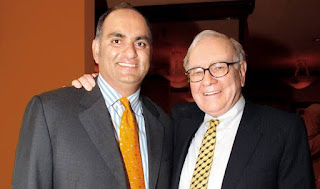I wanted
to write this post about how an average investor, who is not prepared to put in
the time and effort to learn about stock picking, should invest. I came across
some well written blog pieces and articles on the same subject who have put it
more succinctly what I have wanted to say.
The average retail guy should just do an Index or a large cap MF SIP, have some bonds in his portfolio and one term insurance. What he needs is simple advice but the most important thing is sticking with this plan for 20-30 years especially in a vicious bear market when all theory and good advice is ignored and thrown out of the window because the investor panics. Therefore what he should do is to at least learn the basics of how stock markets work, history of financial markets, and above all hire a advisor whom he will trust. Rest is not too complicated. But in today’s world of instant gratification who thinks of 20-30 years down the line. However, the same person will be willing to buy and hold a plot of land or flat for far longer than he will hold a stock.
Am putting a small relevant except from Safal Niveshak's latest blog and the link to that blog along with links to some other articles.
“Vishal : What according
to you is the biggest problem why most investors don’t succeed in the stock
market?
Subra: I think patience.
Go back to what Pascal said, people can’t sit tight. But look at it this way,
you don’t need to do anything else than put money in an index fund. Today you
have an index fund at 0.15%. Believe me, it matches with the best cost in the
world. You can always argue that Vanguard is at 0.02%, but then those volumes
have not built up. So all you do as a kid when you are 23-25 years old, and you
can start with say Rs 2,000 per month, just do an SIP in an index fund. You
will make money in the long run, as the economy grows and the market rises. Even
when the market goes down you will make money as you will get more units. And
look at it over a 10-15 years period. Unfortunately, people cannot do this. I
think they watch too much of TV.
Just don’t do anything
and keep investing in an index fund, and pick up one stock every year after
doing some research and studying say 20-30 companies. It’s not very difficult
to do that.
All you need is one term
insurance, one savings bank account, one index fund, and that’s it. Then,
anybody comes and tells you buy this and buy that, you just need to say no. And
I see portfolios of people who’ve put money in 100+ mutual fund schemes without
understanding what they are doing. You don’t need to do all this! This is bound
to give you sub-optimal returns. Either you be in an index fund or you pick
stocks. If you can’t pick stocks, be in an index fund. That’s fine. Concentrate
on your career.
What is your biggest
asset? Today when you are 25, your biggest asset is the present value of your
future earnings. So that could be say Rs 15 crore for a 25 year old guy. So
that’s your human capital. That is your biggest asset. The most important thing
is to protect it. How will you protect it? You take term insurance, and you
take care of your health. Because if you fall ill, you will eat into that if
you are unable to earn for 1-2 years. That is your most important asset – your
human capital.
Now, if that asset is in
a government job, you’re sure it is like a bond fund. Nothing will happen to
it. You’ll get an indexed pension. So, then your portfolio can be in equities.
But if your human capital is in running a website or courses, things like you
and me do, then that is behaving like equities as your earnings might
fluctuate. Then your portfolio has to include some bonds.”
Excerpt
ends here
So if your main income is like equity, you have to have bonds in
your portfolio. And if your main income is like a bond, then your portfolio has
to be equity.
There are some good
"robo advisors" in the US like marketriders, betterment, wealthfront
and liftoff. Even fidelity and charles schwab are now getting in to this space.
The basic service of these advisors enables you to pick a portfolio of low cost
ETFs or MFs as per your preferences and risk appetite. They then monitor
your portfolio and alert you if you need to re-balance your portfolio at any
point. This kind or service is slowly making its way into India now and I think
will be a large space in the next 5 years.
So to a young person
starting off with their first job in their early 20s, I would say that you have
the most powerful weapon in your hands to beat inflation and that is Time. Use
the first 3-4 years to build discipline of investing a fixed amount on a
monthly basis. In your late 20s or early 30s you will probably get married and
have more responsibilities. And it is at this time that the benefit of having
cultivated the habit of investing systematically which will come to your aid.
Don’t let your own
beliefs, actions and behavior be your own enemy. Also watch less of financial tv channels and read some good financial magazines like
moneylife. They are one of the best
magazines in this space and provide good and clear analysis.
You can go through these
links to read more.

